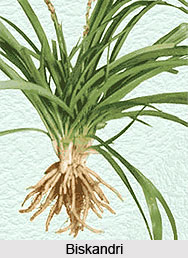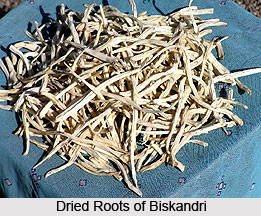 Biskandri is a small perennial herb known for its medicinal values. It is quite popular in India. It has got very good Ayurvedic medicinal properties and is a chief ingredient in the preparation of over a hundred Ayurvedic formulations. Biskandri is actually a commercial drug known as `safed musli` and is considered to be a valuable nervine and general stimulant for strength and vigour. The scientific name of this medicinal plant is Anthericaceae Chlorophytum arundinaceum.
Biskandri is a small perennial herb known for its medicinal values. It is quite popular in India. It has got very good Ayurvedic medicinal properties and is a chief ingredient in the preparation of over a hundred Ayurvedic formulations. Biskandri is actually a commercial drug known as `safed musli` and is considered to be a valuable nervine and general stimulant for strength and vigour. The scientific name of this medicinal plant is Anthericaceae Chlorophytum arundinaceum.
Habitat of Biskandri
Biskandri is found all across the nation but it is mainly concentrated in northeastern India from Bihar to Manipur extending into Myanmar (Burma) and in peninsular India from Odisha to Maharashtra. In South India it is found in Tamil Nadu at an elevation of 1200 m.
Characteristic Features of Biskandri
The basal leaves of Biskandri are spirally arranged. They are sub erect, lanceolate and up to 80 cms in length and 2 cms in width. The flowers are white, star-shaped and 1.8 to 2.3 cms in diameter.
 The sepals of Biskandri are oblong-lanceolate, anthers green to yellow, long or longer than the filaments and are borne in long racemes on heavy stalk up to 1 m tall. The fruits of Biskandri are oval in shape.
The sepals of Biskandri are oblong-lanceolate, anthers green to yellow, long or longer than the filaments and are borne in long racemes on heavy stalk up to 1 m tall. The fruits of Biskandri are oval in shape.
Uses of Biskandri
This medicinal plant is used in traditional systems of medicine including Ayurveda, Unani, and homeopathy. Some of its uses are as follows-
•The root powder of this Indian medicinal plant is fried and chewed to heal mouth and throat ulcers.
•A decoction of the root with turmeric is prescribed for curing rheumatism.
•Among tribal women in central Odisha, an extract of the Biskandri roots is crushed and mixed with rice water for treating dysmenorrhea.
•In Ayurveda, the root of Biskandri is used for treating blood disorders and piles.
•It is also used as an aphrodisiac and rejuvenator.
•The leaves and flowers of Biskandri are edible too.
•Biskandri is used as a curative for physical weakness and many illnesses.
•It is used as a curative for natal and post-natal problems.
•It is used as an immunity-improving drug.
•It is used as a remedy for diabetes and for arthritis.
•It is also used in industries like cosmetics, detergents, dyes, insecticides, paints etc.



















